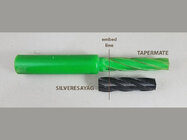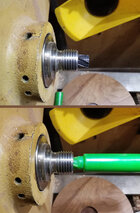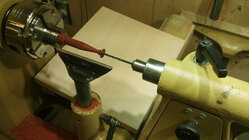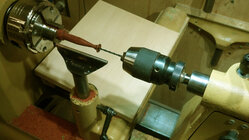That's a good point, no pun intended. And the bit needs to be sharp! It took me a long time to learn to sharpen, especially large diameter bits.
Some things that cause drifting are, (in my opinion) and experience:
- Sharp bits, as mentioned. Sometimes not mentioned - spiral flutes should be sharp, not dull or damaged.
- Slightly bent drill bit, maybe too slight to notice. Examine by rolling on a flat surface (surface plate is ideal)
- No or improper starting hole (I always use center bits or a starter bit). Starting the hole is more than half the battle.
- For larger bits, drilling a starter hole with a smaller bit can sometimes help.
- Wood grain - if not straight, the bit can follow the grain if other things aren't right.
- Too long a bit might flex. If drilling a a deep hole, I start the hole with a short stub (screw machine) bit, drill as deep as it will go, then switch to the longer bit.
- Vibration, wobbling of wood and/or bit. For a deep hole, it's helpful to turn at least the end of the blank round then steady with the hand.
- Speed too slow. If very slow, the bit can wobble more. I find a higher speed can help (for several reasons).
- Sloppy hardware. High quality Jacob's chuck. Clean 2MT on both chuck and tailstock.
- Sloppy hardware 2 - even better, eliminate the Jacob's chuck completely and use taper shank bits for both small and large dia holes.
- Sloppy hardware 3 - low precision lathe construction (as mentioned elsewhere)
- Along with that, the MT surfaces should not be damaged. A MT on the Jacob's chuck can twist if the bit catches and cause galling. A reamer can repair bad galling.
- Clean, round drill bit shank with no problems. Some develop burrs or galling. Use a file to repair or grab a different bit.
- High quality bits. Expensive, but can make a huge difference in the Big Picture.
That's all I can think of at the moment. I can say I haven't had a wandering drill bit for a long time.
A set of center bits are cheap, made for metal turning without live centers.
If possible, I choose one whose outer diameter is a bit larger than the drill bit.
I keep one in a spare Jacob's chuck at all times.
View attachment 69067
Two ways to prevent bits and Jacob's chuck from rotating in the tailstock:
1) I use a rod that perfectly fits the chuck key hole in the chuck.
A good strap wrench also could work.
View attachment 69068
2) Keep taper shank bits from rotating with small channel lock pliers, or vise grips.
View attachment 69069
If without one, this is great for clean 2MT sockets. There are other methods.
View attachment 69071
JKJ




